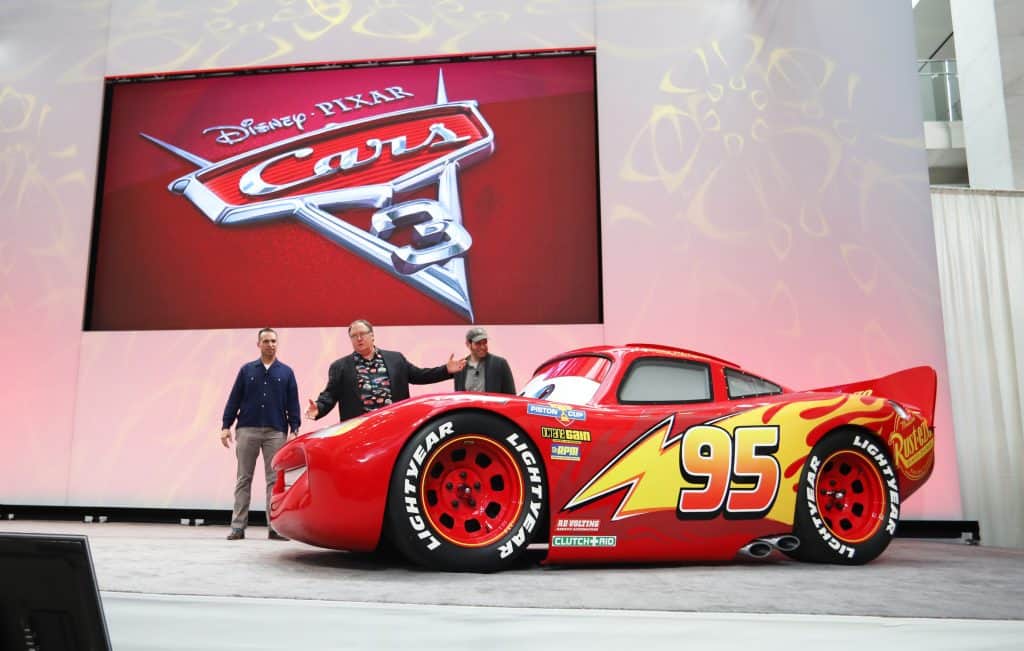
The first day of AutoMobili-D, the AutoMobility side of the Detroit Auto Show NAIAS was almost more Hollywood than Automobility LA. Waymo revealed the self-driving Pacifica Hybrid, Pixar showed the first clip of Cars 3 and Tim Stevens who hosted panels at AutoMobility LA hosted a panel with many of the same people who appeared at AutoMobility LA in the past.
Michigan Gov. Rick Snyder gave remarks and helped inaugurate the AutoMobili-D exposition and Planet M – the state of Michigan-sponsored showcase of leading mobility companies and initiatives taking place in Michigan.
Waymo staged the world unveiling of the self-driving Chrysler Pacifica Hybrid, which is one of 100 co-developed by the Google automotive unit and Fiat Chrysler Automotive. Waymo CEO John Krafcik, the keynoter at the opening of AutoMobili-D, said that some of these vehicles would begin appearing on public roads in California and Arizona later this month, adding to the 2.5 million in self-driven miles already compiled by Google-designed systems in vehicles around the world.
NOTE: The human-driven Chrysler Pacfica is nominated for a Tech CARS Award, please show you opinion and cast your vote.
The vehicle shown today is one of 100 co-developed by the Google automotive unit and Fiat Chrysler Automotive. Krafcik said that some of these vehicles would begin appearing on public roads in California and Arizona later this month, adding to the 2.5 million in self-driven miles already compiled by Google-designed systems in vehicles around the world.
“This is the first self-driving minivan capable of getting door to door without a person at the wheel,” Krafcik said. “It’s the first product of our first collaboration with an automaker working on a mass-production platform.”
Even as Waymo has improved its LIDAR technology, at the heart of the recognition of the external world needed for self-driving, it has dropped the cost of LIDAR by more than 90 percent in just two years from about $75,000 per vehicle.
Cars 3
Pixar Animation Studios featured the global reveal of the first clip from this summer’s “Cars 3” and the debut of a life-size version of “Lightning McQueen,” one of the stars of the popular series of animated films.
Pixar’s John Lasseter revealed that NAIAS was the inspiration behind the “Cars” movies.
Cars 3 will feature competition between a new character, the racer Jackson Storm, a rookie car that seeks to push the franchise’s first and iconic racer character, Lightning McQueen, from the pinnacle of the racing world.
“This is the first look at an exclusive clip from the movie,” John Lasseter, chief creative officer for Walt Disney and Pixar Studios, told AutoMobili-D. “No one has seen it outside the walls of Pixar automation studios.”
Jay Shuster and Jay Ward, two creative executives at Pixar, discussed the creation and introduction not only of Jackson Storm, a sleek blue racer in contrast with McQueen’s higher-profile red form, but also of Cruz Ramirez, who is a yellow sports car.
“She’s not a race car but a strong female character who has to meet the race cars at their level,” said Shuster, Pixar production designer. “She’s rooted in American muscle cars and the Euro design aesthetic.”
Pixar executives said that former Ford chief designer J. Mays helped them design the two new characters for Cars3, which will debut this summer.
Financing Detroit
Media also heard financial-services entrepreneur Dan Gilbert, who has helped remake Detroit, give an upbeat assessment of the Motor City’s current and future economy. Gilbert promised that the city would be seeing “$2 billion to $4 billion in new construction in the ground in the next 18 months” and the erection of a handful of buildings of more than 25 stories over the next several years.
Fontinalis Investment Chief Chris Thomas, head of an early Detroit-based investor in mobility services and concepts, said “Detroit’s past and present has positioned us well to drive the future of mobility, to become one of its global hubs.” He noted that “transportation is the second-biggest expense” for the average U.S. household and that a new age of autonomous transportation “will change the world.”
Also featured on day one of AutoMobili-D was a panel discussion hosted by Roadshow by CNET. Three key executives in the U.S. auto industry’s advance toward autonomous driving said that they expect rapid advances in mobility technologies, legislation and regulation, and consumer acceptance in a paradigm shift that already has gained remarkable momentum in the last two years.
Ken Washington, senior vice president of research and advanced engineering for Ford; Danny Shapiro, senior director of automotive for technology supplier NVIDIA; and David Strickland, former head of the National Highway Traffic Safety Administration and now counsel for the Self-Driving Coalition, made their assessments during a discussion at AutoMobili-D that was moderated by Tim Stevens, editor at large of Roadshow by CNET.
The panelists agreed that automated-driving technology, connectivity platforms and other new features of the driving experience already have become more determinative in many consumers’ automotive purchases than traditional appeals such as horsepower and handling.
Washington said Ford’s goal for mobility-services technology is “to unlock a vast array of new user experiences.”
The role of artificial intelligence in perfecting self-driving technology is crucial, Shapiro said. “The beauty of artificial intelligence [using] deep neural networks,” he said, “is that we are able to quickly train it” through repeated simulation of driving experiences.